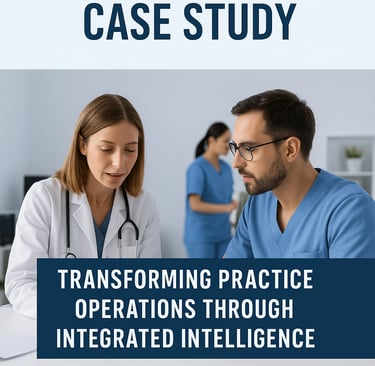How AI Turned RCM from a Headache into a Growth Engine
AI RCM case study: unified billing and books, cut denials 66%, reduced A/R days, and boosted collections 18%. Read more.
10/24/20252 min read


How AI Turned RCM from a Headache into a Growth Engine
A case study: Mid-Atlantic Specialty Medical Group
Many private practices treat revenue cycle management (RCM) like a back-office chore: submit claims, wait for payments, and scramble when denials happen. That approach hides a lot of lost revenue and drains staff time. Mid-Atlantic Specialty Medical Group — a 12-provider multispecialty practice (orthopedics, cardiology, primary care) with three locations and about $8.5M in annual revenue — lived that reality. Their billing vendor and bookkeeping firm operated separately, and the result was predictable: slow closes, confusing AR, and constant firefighting.
They chose an AI-native RCM platform. The results were dramatic — and instructive for any practice that wants to run like a business, not a claims factory.
The problems (short)
Data silos: Billing and accounting didn’t speak to each other. Staff spent 8–12 hours a week manually reconciling payments and ledgers. Month-end took 12–15 days.
Reactive denials & AR: A 14% denial rate and 58 days in A/R meant cash was slow and appeals were late (18–22 days). No visibility on which payers, codes, or providers caused the most trouble.
Transactional vendor relationship: Monthly reports arrived late, were shallow, and offered no proactive guidance. The vendor only reacted when things broke.
What the AI RCM platform did
1. Built a single source of truth
The platform integrated the practice management system, EHR, bank feeds, and accounting software in real time. Payment posting, deposit matching, and GL entries synchronized automatically. Staff no longer copied numbers by hand.
2. Stopped denials before they happened
Machine learning models scored claims on 50+ variables (coding, authorizations, payer behavior, documentation). High-risk claims were routed for pre-submission review. The system also automated prior-auth tracking and used NLP on provider notes to suggest correct codes and flag medical-necessity gaps.
3. Made the vendor a strategic partner
Real-time dashboards showed claim status, denial trends by payer/provider/CPT code, collections, and productivity. Weekly insights and monthly strategic reviews used predictive analytics to forecast revenue and recommend actions — not just report past problems.
The results (12 months)
Denial rate: 14% → 4.8% (66% reduction) — recovered an estimated $420,000.
Days in A/R: 58 → 39 days — improved cash flow, freeing $275,000 in working capital.
Clean claim rate: 82% → 94%; first-pass resolution: 92%.
Net collections: +18% → ~$1.5M additional annual revenue.
Operational gains: 520+ staff hours freed annually; month-end close reduced to 3–4 days; appeals submitted in 4–6 days with success rate rising from 48% to 71%.
Strategic wins: Cardiology denials fell 58% after targeted education; proactive payer alerts prevented ~180 denials tied to coding changes. ROI turned positive within six months.
Why it worked
Three factors made the transformation possible:
Unified data: One platform removed manual reconciliation and exposed the true cash flow.
Predictive, not reactive: AI flagged risk early and prioritized work by expected recovery value.
Transparent partnership: Continuous dashboards and predictive reviews made the vendor a strategic part of the practice’s finances.
Key takeaways for practice leaders
Don’t accept disconnected systems and monthly reports as “normal.”
Prioritize tools that integrate billing, clinical, and accounting data.
Look for AI that explains decisions (why a claim is risky) and focuses on high-ROI work (appeals with the best chance of success).
Measure vendors by outcomes (Days in A/R, clean-claim rate, net collections), not just task completion.
Next steps (practical)
If your practice has manual reconciliations, long closes, or high denial rates, start with a small sample: share 30 days of PM claims, ERA/835 files, and GL postings and ask for a reconciled snapshot. A quick proof-of-value often shows where the largest recoveries and efficiencies live — and whether an AI approach can shift your RCM from cost center to growth engine.
